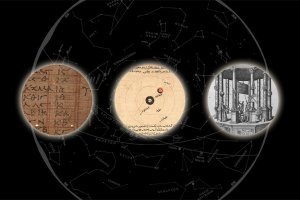
Trace how astronomy was developed, studied, and disseminated through the centuries, from 1500 BCE to the Renaissance. On display is material drawn from the University of Michigan collections dealing with the history of early astronomy: manuscripts, early printed books, and artifacts illustrating Mesopotamian, Greek, Islamic, and Western European astronomy.
This exhibit and its permanent online counterpart (https://umlib.us/earlyastronomy) are part of the Aratus Project, which was sponsored by the National Science Foundation and led by Prof. Francesca Schironi. The core of the project has been to study Aratus’ "Phaenomena," the most important poem on stars and constellations of the Graeco-Roman ancient world, and its exegetical tradition. Read an annotated edition and English translation of "Phaenomena" and its commentaries (https://aratus.classics.lsa.umich.edu/). The physical and online exhibits place this research work within its later intellectual and historical context.
Curated by: John Steele, Professor of the History of the Exact Sciences in Antiquity, Department of Egyptology and Assyriology, Brown University; Francesca Schironi, U-M Professor of Classical Studies; Evyn Kropf, U-M Librarian for Middle Eastern & North African Studies; Pablo Alvarez, U-M Curator (Special Collections Research Center).
Check Hatcher Gallery Exhibit Room hours: https://myumi.ch/2mx44
This exhibit and its permanent online counterpart (https://umlib.us/earlyastronomy) are part of the Aratus Project, which was sponsored by the National Science Foundation and led by Prof. Francesca Schironi. The core of the project has been to study Aratus’ "Phaenomena," the most important poem on stars and constellations of the Graeco-Roman ancient world, and its exegetical tradition. Read an annotated edition and English translation of "Phaenomena" and its commentaries (https://aratus.classics.lsa.umich.edu/). The physical and online exhibits place this research work within its later intellectual and historical context.
Curated by: John Steele, Professor of the History of the Exact Sciences in Antiquity, Department of Egyptology and Assyriology, Brown University; Francesca Schironi, U-M Professor of Classical Studies; Evyn Kropf, U-M Librarian for Middle Eastern & North African Studies; Pablo Alvarez, U-M Curator (Special Collections Research Center).
Check Hatcher Gallery Exhibit Room hours: https://myumi.ch/2mx44